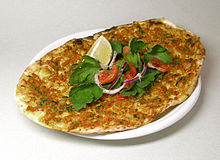라흐마쿤
Lahmacun 라흐마쿤 샐러드 | |
| 대체 이름 | 람바진, 라마진, 라흐마준, 라흐마준[1][2] |
|---|---|
| 코스 | 주된 |
| 원산지 | 오스만 제국 |
| 서빙 온도 | 따뜻해 |
| 주요 성분 | 다진 고기, 야채 및 허브 |
| 시리즈의 일부 |
| 이즐리 피데 |
|---|
 |
Lahmacun (Arabic: لحم بعجين, Armenian: լահմաջուն also lahmajun and other spellings) is a Middle Eastern flatbread and meat dish.그것은 다진 고기, 다진 야채, 그리고 양파, 마늘, 토마토, 홍고추, 파프리카와 같은 향신료로 맛을 낸 후 [3]구워진 납작한 빵으로 구성되어 있다.라흐마쿤은 종종 피클, 토마토, 고추, 양파, 상추, 파슬리, 그리고 구운 [4][5][6][7]가지를 포함한 채소로 싸여진다.
그것의 모양과 표면적인 유사성 때문에, 그것은 때때로 아르메니아 피자,[8] 터키 [9]피자 또는 유사한 이름으로 묘사된다.그러나 피자와 달리 라흐마쿤은 보통 치즈와 함께[10] 준비되지 않고 껍질이 [11]얇다.
라흐마쿤은 아르메니아에서 [10]인기 있는 음식으로, 그곳은 라마조라고도 [12]불린다; 터키, 이라크, 레바논, 시리아[13][14], 팔레스타인,[12] 그리고 전 세계 아르메니아, 터키,[10] 아랍 공동체에서 라흐마쿤이라고 불린다.
어원학
The name entered English from Turkish: lahmacun and Armenian: lahmaǰun, both of which derive from the Arabic: لحم بعجين, laḥm ʿajīn, laḥm bi-ʿajīn, meaning "meat with dough".[1][2][13]터키어는 "lah-ma-june"[15]처럼 발음된다.
역사
중동의 납작한 빵은 탄두와 타바와 같은 금속 프라이팬에서 수천 [2]년 동안 요리되어 왔다.그것들은 편리함과 휴대성을 위해 고기와 다른 음식들을 포장하는 데 사용되어 왔다.하지만, 중세시대에 큰 돌 오븐이 널리 보급되기 전까지, 고기나 다른 음식으로 채워지거나 위에 올려진 납작한 빵은 함께 구워지지 않았고, 빵과 토핑을 동시에 요리했다.스피하와 마나키쉬와 같은 다양한 요리가 오스만 제국의 일부 국가, 특히 터키, 아르메니아, 시리아, 레바논, 이라크에서 인기를 끌었다.향신료를 뿌린 고기를 얹은 얇고 납작한 빵은 람바진(lam b'ajin, 반죽을 넣은 고기)으로 알려지게 되었고, 줄여서 라흐마진(lahmajin)과 비슷한 이름으로 [2][13]불리게 되었다.
아이퍼 바투는 20세기 중반까지 이스탄불에 [16]라흐마쿤이 알려지지 않았다고 주장한다.1950년대 이후 터키에 널리 퍼지기 전에는 아랍국가와 터키 [17]남부 우르파와 가지안테프 주변에서 볼 수 있었다.
식량 전쟁
아르메니아와 터키 간의 적대적인 관계 때문에 러시아에서 음식을 제공하는 아르메니아 음식점의 개점에는 [12][18]몇 가지 항의가 있었다.
아르메니아계 미국인 모델인 킴 카다시안은 자신의 인스타그램에 "누가 라흐마쿤에 대해 아는가?이것은 우리의 아르메니아 피자입니다," "아버지는 항상 스트링 치즈를 얹고 오븐에 넣고 정말 바삭하게 만듭니다," 이것은 터키 소셜 미디어 사용자들 사이에서 분노를 불러일으켰고 라흐마쿤을 "아르메니아 피자"[19]라고 묘사했다고 그녀를 맹비난했다.
레퍼런스
- ^ a b "Entry: lahmacun". American Heritage Dictionary. Houghton Mifflin Harcourt. Retrieved 2020-01-07.
- ^ a b c d Marks, Gil (17 November 2010). Encyclopedia of Jewish Food. HMH. ISBN 9780544186316 – via Google Books.
- ^ Alkan, Sena (19 November 2016). "A delicious, fresh experience: try lahmacun". Daily Sabah. Retrieved 16 January 2020.
The true origin of lahmacun is a mystery...
- ^ Ghillie Basan (1997). Classic Turkish Cookery. Tauris Parke Books. p. 95. ISBN 1-86064-011-7.
- ^ Allen Webb (2012). Teaching the Literature of Today's Middle East. Routledge. pp. 70–. ISBN 978-1-136-83714-2.
- ^ Sally Butcher (2012). Veggiestan: A Vegetable Lover's Tour of the Middle East. Anova Books. pp. 128–. ISBN 978-1-909108-22-6.
- ^ Jeff Hertzberg, M.D.; Zoë François (2011). Artisan Pizza and Flatbread in Five Minutes a Day. St. Martin's Press. pp. 216–218. ISBN 978-1-4299-9050-9.
- ^ "'Armenian Pizza' Is the Comfort Food You Didn't Know You Were Missing (Recipe)". Smithsonian Magazine. Retrieved 16 January 2020.
No one knows for certain whether lahmacun’s roots lie in Armenia, Turkey, or elsewhere in the Middle East. “The race to find where these ancient foods originated is not fruitful territory,” cautioned Naomi Duguid, author of Taste of Persia: A Cook's Travels Through Armenia, Azerbaijan, Georgia, Iran, and Kurdistan. After all, meat-enhanced flatbreads are ubiquitous throughout the region...
- ^ "Turkish flatbread lahmacun - just don't call it pizza". South China Morning Post. 4 April 2015.
- ^ a b c Carol Helstosky (2008). Pizza: A Global History. London: Reaktion Books. pp. 59–. ISBN 978-1-86189-630-8.
- ^ The Routledge Handbook of Mobilities. Routledge. 10 January 2014. ISBN 9781317934127. Retrieved 16 January 2020.
- ^ a b c McKernan, Bethan (27 October 2016). "A 'pizza war' has broken out between Turkey and Armenia". The Independent. Retrieved 10 December 2016.
- ^ a b c Marks, Gil (1999). The World of Jewish Cooking. New York: Simon and Schuster. p. 37. ISBN 978-0-684-83559-4.
- ^ Dmitriev, Kirill; Hauser, Julia; Orfali, Bilal (2019-09-24). Insatiable Appetite: Food as Cultural Signifier in the Middle East and Beyond. Brill. ISBN 978-90-04-40955-2.
- ^ Stein, Rick (30 July 2015). Rick Stein: From Venice to Istanbul. Random House. ISBN 9781448142729 – via Google Books.
- ^ Bartu, Ayfer Suna (1997). Reading the Past: The Politics of Cultural Heritage in Contemporary Istanbul. University of California, Berkeley. p. 149.
We became a nation of lahmacun eaters. Fifty years ago no one in Istanbul knew what lahmacun was - or if we did, we called it pizza.
- ^ Bartu, Ayfer (2001). "Rethinking Heritage Politics in a Global Context". In AlSayyad, Nezar (ed.). Hybrid Urbanism: On the Identity Discourse and the Built Environment. Greenwood Publishing Group. p. 154. ISBN 978-0-275-96612-6.
- ^ "Lahmacun Kimin?". kapsamhaber.com/ (in Turkish). Retrieved 2018-12-10.
- ^ "Kim Kardashian faces Turkish backlash after calling lahmacun 'Armenian pizza'". 27 March 2020.



